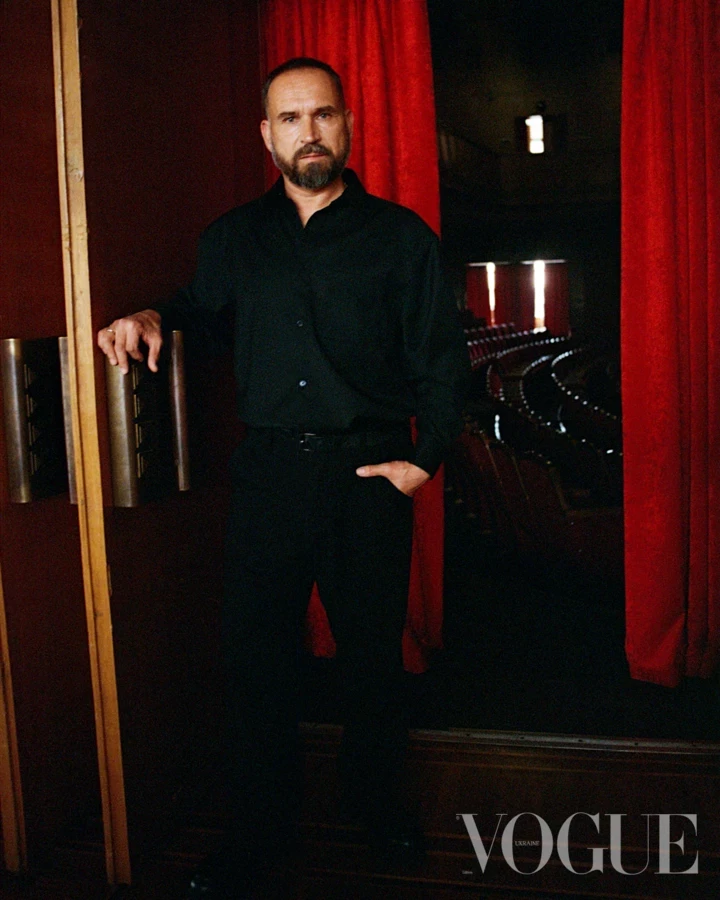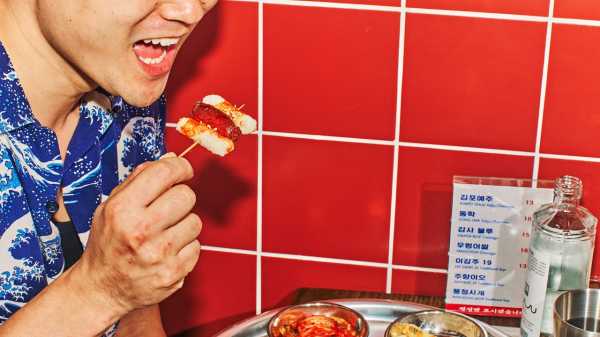
Save this storySave this storySave this storySave this storyYou’re reading the Food Scene newsletter, Helen Rosner’s guide to what, where, and how to eat. Sign up to receive it in your in-box.
A whiteboard affixed to the glass door of Kisa, a Korean restaurant that opened recently, on the corner of Allen and Houston Streets, lists approximate wait times for parties of varying sizes. On a recent evening, rolling up at the geriatric hour of 5:30 P.M., I learned that the wait for a party of two would be around forty-five minutes; by the time I finished my meal, the estimates had grown to an hour and a half for two people and nearly three hours for a group of five or six. (At especially busy times, the board simply reads “Waitlist is closed.”) Kisa does not take reservations, only walk-ins, an uncommon approach in this era of cutthroat online machinations, though it makes perfect sense: Kisa is a diner, and a fairly bare-bones one. Operated by the duo behind the sceney NoHo restaurant C as in Charlie, the Korean-born restaurateurs David JoonWoo Yun and Steve JaeWoo Choi, and a partner, Yong Min Kim, the restaurant is an homage to South Korea’s “drivers’ restaurants” (kisa sikdang), no-frills establishments whose limited menus, speedy service, and affordable prices are perfectly tuned to the needs of taxi drivers. Why would an exhausted cabbie want to play the Resy game just to grab dinner between fares?
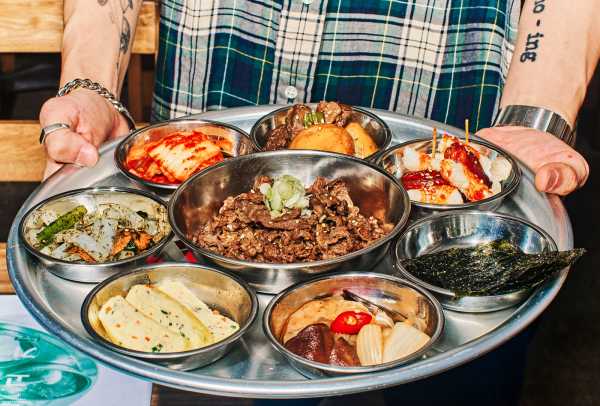
Meals come with a choice of entrée surrounded by an array of banchan.
Like the restaurants on which it’s modelled, Kisa offers baekban (home-style, though it literally means “white rice”) set meals, featuring a centerpiece entrée—your choice of bulgogi, spicy pork, spicy squid, or a vegetarian option—rounded out with rice, soup, and an array of banchan. The emphasis, it seems, is on getting good food, and lots of it, out quickly, and cheaply: where C as in Charlie is sleek and stylish, the room and the food and the party-ready people in it all seemingly dying to be photographed and talked about, Kisa is utilitarian, almost austere. It has the unpretentious patina of a restaurant that’s been there forever and has no time for the fripperies of social media or best-of lists or heatmaps. There are walls colored in landlord off-white; haphazardly positioned wall art and tchotchkes; an ancient cuboid CRT TV sitting on a high shelf in a corner of the dining room, permanently flickering. Even the restaurant’s sign, a marquee running along the outside trim with messaging entirely in Korean—“Southeast Intersection Driver’s Restaurant,” facing Allen Street; “Famous Driver’s Restaurant,” along Houston”—feels like a holdover from some earlier era, when the neighborhood was a locus of Korean-immigrant culture.
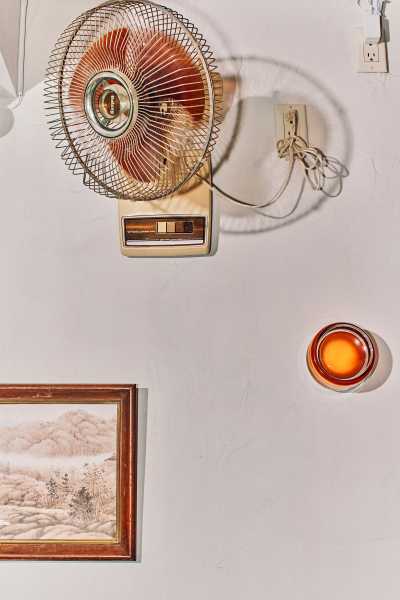
The time-worn feel of the restaurant is pure artifice, but an unknowing diner might well be fooled.

Fitting the restaurant’s tremendous circular metal plates on its small tables presents a real-life geometry problem.
Except that it never was. The most marvellous thing about Kisa is the comprehensiveness of its artifice, its truly astonishing feat of sprezzatura: despite its worn-in feel, the entire restaurant is in fact brand new. The address’s previous tenant, a mediocre Cuban restaurant, was slick and snazzy; the Lower East Side, for all its global melting-pottery, has never been a Korean enclave. If you know what to look for, you’ll find that Kisa’s narrative immersion extends beyond the restaurant’s walls: stickers adhered to nearby power boxes and lampposts advertise (again, entirely in Korean) a “Driver’s Restaurant,” with Kisa’s phone number beneath.

The low-key décor includes printed-fabric cushions, tied to the seats of the chairs with bows, and faded baby photos in frames.
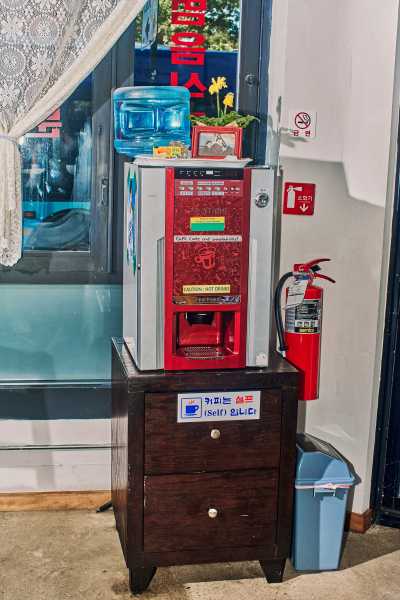
After paying the bill, diners are handed a quarter to use in the vintage automatic coffee machine by the door.
This level of meticulous world-building is nothing new in restaurantland. Diners are used to being transported, via the meticulous construction of space and vibe, to the faraway, the unfamiliar, the nostalgically yearned-for. Normally, though, the atmosphere is designed to dazzle, telling a story of glamour and grandeur—the sultry greenery of the Caribbean, Positano in the fifties. What’s intriguing (and, to me, incredibly fun) about Kisa is that it applies the same aesthetic rigor in the opposite direction, away from the aspirational. Generally, when a buzzy restaurant’s food is of humble origin—like, say, the Indian roadside fare served at Jazba, a glossy, newish restaurant in the East Village, or the “street food” at the fancy new Tribeca steak house Beefbar—we tend to clumsily refer to it as “elevated,” a celebration of the everyday dressed up with a hip soundtrack, fancy tableware, pricey cocktails, and oligarchic ingredients. (Beefbar’s quesadilla, which includes Wagyu and truffle, is twenty-eight dollars.) Not so at Kisa. Call it a glow-down—an unphotogenic room, clashing and utilitarian signage, low-key food and service. The result is a slightly uncanny, tremendously compelling tension. The illusion is so straight-faced, so documentary, that an unknowing diner, wandering past, could sit down for a meal and have no idea that they were on a stage set and not in some off-radar, hole-in-the-wall discovery. I kept looking around for some kind of cool-kid tell: a secret list of high-end Champagnes, or a hidden door to a V.I.P.-only basement bar.
This conceit could easily have landed wrong, slipping perhaps into a distasteful sort of blue-collar cosplay. Kisa pulls it off, however, thanks in part to the obvious affection that the restaurateurs have for the diners to whom they pay homage. The old-school fan mounted to the wall, the printed-fabric cushions tied to the seats of the chairs with bows, the faded baby photos in frames—these details feel like they could only have come from a loving hand. Perhaps more important, the food is simply terrific. The prices, while not Seoul-cheap, are modest by the standards of the high-traffic Lower East Side—each thirty-two-dollar meal includes rice and soup (tofu and greens in a gently fiery broth) and seconds on the banchan. The kitchen, overseen by the chef Simon Lee, produces meals both excellent and abundant. When the food arrives, it presents a real-life geometry problem: how to position the bowl of rice, the bowl of soup, and the tremendous circular metal plate on which the rest of your dinner is arranged, your entrée of choice in the center, with little bowls of banchan arrayed around it like petals on a flower. On one visit, sensing the need for strategic dishware placement, I tried to be helpful and moved my water glass and chopsticks to make room. My server stopped me, with the soft forbearance of a person who’s gone through this dance a thousand times before. “I know how to make it work,” he said, and quickly Tetris’d everything into a staggered layout in which somehow, barely, every dish and cup and utensil fit on the slightly-too-small table.
Helen, Help Me!
E-mail your questions about dining, eating, and anything food-related, and Helen may respond in a future newsletter.
I ate at Kisa two days in a row, and I would gladly have gone back for more. Lee’s jeyuk (spicy pork) is sliced whisper-thin and grilled to a caramel sweetness; the ojingeo bokkeum (spicy squid) is charred and chewy, the heat of chilies given an edge of green thanks to fresh scallions. The vegetarian entrée, a bibimbap-style assemblage of pickled and steamed vegetables, is a bit bland, in both heat and flavor, but that mellowness is offset by joyous, colorful banchan—seven varieties, on my visits, including cabbage kimchi and sheets of roasted seaweed. There were slices of fluffy rolled omelette, wiggly strips of mung-bean jelly tossed in a seaweed purée, and sweet raw soy-sauce-cured shrimp, with mushrooms. The potato jorim, braised in sweet soy sauce, with tender hunks of beef, could serve as a meal on its own; the sotteok sotteok—skewers of alternating chewy rice cakes and cocktail weenies, brushed with gochujang—are sticky and savory and perfectly silly. There’s no dessert menu, but, after paying the bill at the end of the meal, you’ll be handed a quarter for the vintage automatic coffee machine by the door, which dispenses your hot chocolate, black-bean latte, or milky coffee into a paper cup that holds just enough to last you a half block beyond Kisa’s cab-driver fantasy—a little souvenir, hot and sweet, to bring back with you into the real world. ♦
Sourse: newyorker.com


